e. asian | 23 | tme they/them | general dni criteria no anti-antis | komaedaism is nagito's interpretation of marxism specific to their post-game communal way of living!
Don't wanna be here? Send us removal request.
Audio
Danganronpa 2: Goodbye Despair - Ms. Monomi’s Practice Lesson
411 notes
·
View notes
Note
My Water just Broke

Go to a hospital.
That’s a tip from Komaeda. Don’t you forget it!
10K notes
·
View notes
Text
https://www.digitallydownloaded.net/2017/03/review-danganronpa-1-reload-sony.html
https://www.digitallydownloaded.net/2014/07/game-theory-danganronpa-and-monokuma.html
0 notes
Text
ok akio's tower gets called a "penis tower" a lot but that's so freudian and this is a jungian and lacanian kind of series u kno...if we're gonna look for psychoanalytic themes in utena it's not gonna be a simplistic understanding of freud. like the black rose arc is all about the imago! the mirror stage!!!!!!
323 notes
·
View notes
Photo

i’ll get to drawing new dr stuff later but this has been sitting around look. Look
1K notes
·
View notes
Text
tumblr
mondo is arrested for multiple felonies
3K notes
·
View notes
Text
wow chihiro's free time events... she defined "ego" (in alter-ego) as having consciousness/awareness, which is v jugnian (and already we see how Alter Ego functions just as J/ng explained the ego's function: reacts to the outside world, threshold of consciousness). i'm starting to think Ch. 3, with the mult. transformation motifs and explicit mentions of conscious and unconscious lol, is commenting on failed individuation processes...? maybe for taka but. idk what it all means like how it all connects gah. and how does this relate to the zero-sum thinking bias?
0 notes
Text

"didn't i feel it, didn't i know? there's something between us- a sort of pull. something you always do to me and i to you."
433 notes
·
View notes
Text
“Prologue and chapter one partners” (DR1 and DR2 spoilers)

When you have explicit parallels such as these two and the fandom still refuses to acknowledge that Hinata likes Ko. Ko shares many parallels with Sayaka the point of is to highlight his importance to Hinata.
Hinata’s feelings became complicated over the course of the killing game, but it was never one-sided. Said complicated feelings were resolved in the OVA and Hope Arc and they are shown to be closer than they used to be. They are together once again, spending time together and standing a little bit away from everyone else.

We even have the Otomedia poster where Komaeda is referred to as Hinata’s “boyfriend” and the context is obviously romantic, showing that a romantic attraction can develop from Hinata’s side under healthier circumstances.
The Sayaka’s smile and Ko’s laugh one is a blatant parallel.
But a more accurate translation of the second one would be “Komaeda… I’m sure that I owe you my life.” as the rough translation for きっと (kitto) is “surely” or “undoubtedly” and 俺の命の恩人 (ore no inochi no onjin) translates to “my lifesaver”. I am not proficient in Japanese but I verified this with a friend who is. It is basically a bold expression of gratitude, not a hesitant one, as shown in the localization.

585 notes
·
View notes
Text
The Multilayering of Nagito Komaeda's character. A (100% serious) shitpost.
*minor Danganronpa 2 spoilers ahead*
So I’ve been thinking why Komaeda’s character fascinates and intellectually stimulates me so much and yesterday an epiphany came to me. In this post I’ll sketch the idea very briefly.
There are roughly at least five layers of Komaeda’s character that could have interested me, with differing extent of ‘depth’ or universal applicability.
Layer 1 is basically 'Komaeda has a striking character design’ or 'Komaeda is a villain with some impressive presence’. Which I believe are opinions generally endorsed by users who don’t vehemently hate Komaeda.
Layer 2 is when you know about his backstory, his beliefs and motivations behind his major actions. At this point you’ll start to sympathize with him, and this point he’s multi-faceted and complex, and far beyond a one-dimensional character.
Layer 3 is where you 'piece the puzzle together’, where you pick up all the small aspects and nuances in his characterization and conjoin them with the 'diagnostic factors’ in Layer 2, having experienced the standalone dynamics he manifested when he’s on the move. And then you’ll be able to see his character as a very well-designed and intricately coherent machinery, who both functions as his own being and serves certain rhetorical significance to the story’s motif.
Layer 4 is, about 'meta narratives’, about the phenomena his character created among the audience that explained, or justified Layer 3 further. For example how he’s still largely distrusted by the fandom when he practically almost never told any lie, how his sharp perceptiveness and keen intelligence shone through his deep self-hatred and likely dementia and people still went 'oh he’s not that smart it’s just his bullshit luck’, or how he loves so profoundly and genuinely and people brush it off as 'oh that fucker knows no love he just admires hope’. Yet they had the audacity to question why he hates himself so much.
( This layer might also include the idea that Komaeda is 'Ultimate Love’, as his honesty, his pure ideological and emotional transparency is what inspires the true, unquestionable and unwavering love that brings people close to each other regardless of personal, cultural and societal barriers. It’s likewise among his effects on the audience. )
And layer five is, roughly about a primordial power of life in pursuit of battling the universal increase in entropy I guess. But I am yet too paramecium-brained to properly demonstrate it as we speak.
In my past Komaeda writeups I mostly touched on Layer 2-4 and scarcely ever touched on Layer 1 or 5 for, reasons.
Thanks for coming to my TED talk.
48 notes
·
View notes
Text
A brief, cursory write-up on Komaeda’s character.
This is not going to be a comprehensive character analysis.
Character-wise why I find Komaeda exceptionally well-handled:
You can almost tell they started Komaeda’s character concept as some crazy ass pull, they endowed him this super-awesome super-cool anime superpower of “pure luck” yet slowly they rounded him up by adding realistic aspects to a mere trope. His luck had setbacks. While it secures him a considerable increase of probability in certain events, or grant him some unexpected personal gains, it attracts tremendous bad luck to people around him, leaving his life pathetic and loveless.
Now then, I said Komaeda is rather realistically written because he’s unlike those anime characters who had a loveless, hopeless upbringing yet came off pretty much perfectly functional with just a few notable personality quirks (Harumaki from V3 and Ever17’s Tsugumi Komachi came to mind). Normally in real life when you had an inescapable shit early life, you wouldn’t likely come out intact. And Komaeda didn’t. For relatively callous, apathetic, indifferent personalities (Akane, everyone?) they’d develop a habit to brush off or neglect what victimized them, but Komaeda had it rough as we can almost tell Komaeda used to be supposedly very astute, perceptive, sensitive, empathetic, even painfully so. Given his predisposition to digesting every droplet of suffering he witnessed or underwent, he forced himself to bend every fibre of his being in order to not succumb to despair.
What else came after his luck? The immense guilt of bringing doom to the people he loved, the unfulfilling sense of personal achievements due to lack of involvement of self-actualization, the hopelessness of incapability to challenge his own fate…all resulted in his deadly deficiency in self-worth. Since ensuing tragedies are coded into his being, and he failed to find any inherent value in himself anyway, what’s the optimal thing to do? He became suicidal and/or sacrificial. Nothing he ever experienced felt correlated to the sense of true happiness, he couldn’t help but drown in the sea of abysmal despair; philosophically speaking, what’s there to desire for in universal life? He had nothing but to grasp onto the groundless ideal of Hope.
For a lack of proper guidance and human interactions in his life he developed some strange coping mechanisms. He grew detached from his own emotions, obsessed over some dichotomic ideals, and his dementia only greatly exacerbated that. He could never be the person he was supposed to be. Death is warranted, yet dying an inconsequential, lonely death is hopeless, thus his dangerous mindset was established during the killing game. His character seem so erratic at a first glance but every single facet of his being can be traced back to very simple but compactly interlinked origins. From these origins, the way he became who he was is remarkably organic, intelligible and, human.
His characterization as a whole is somewhat of a monument for its own merits.
42 notes
·
View notes
Photo

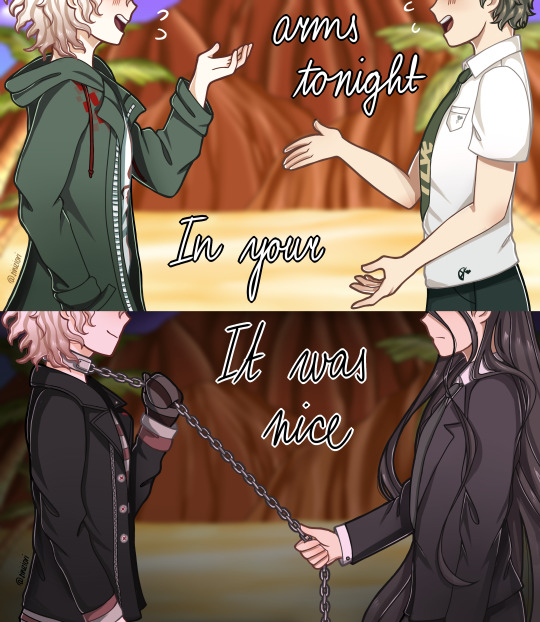
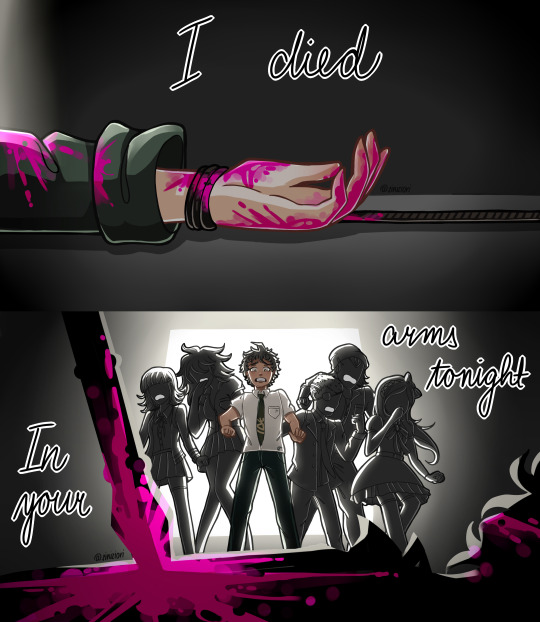



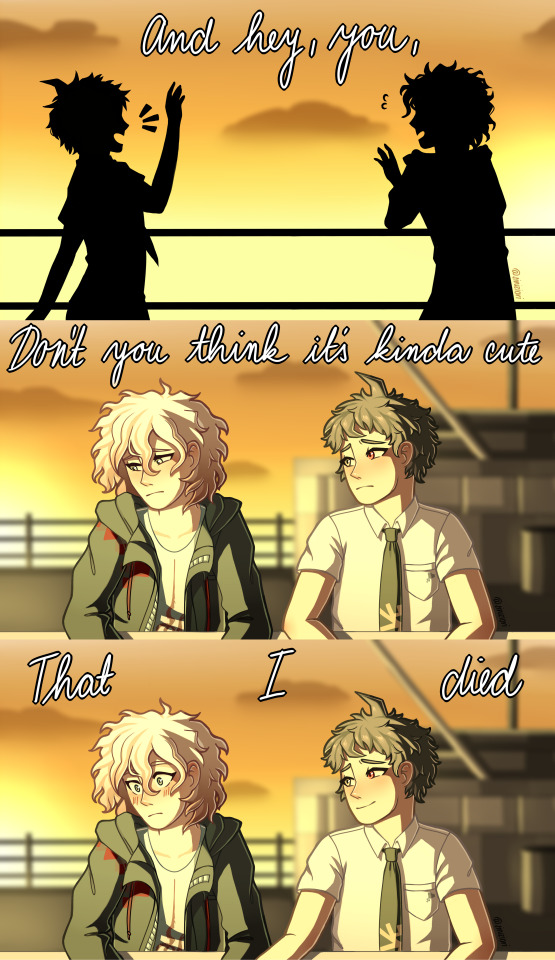
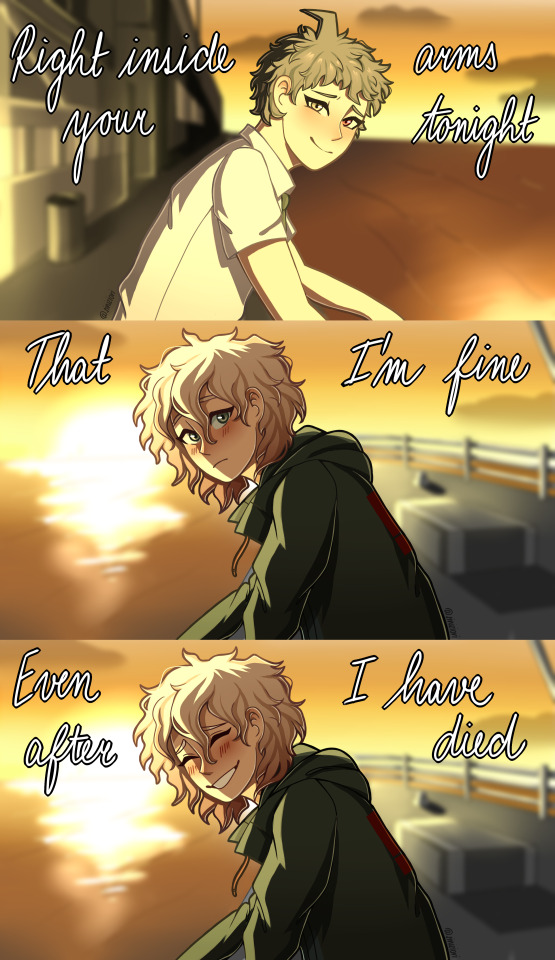
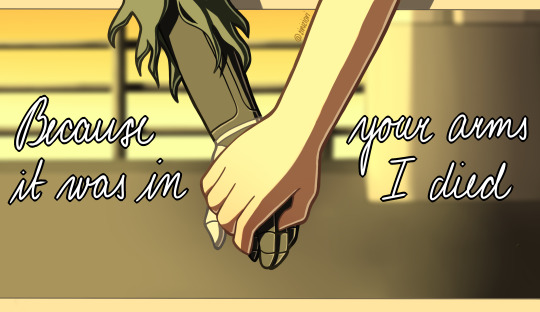
I cry in the afterlife I cry hard because I have died And you’re alive I try to escape afterlife I try hard to get back inside Your arms alive
Arms Tonite // Mother Mother
8K notes
·
View notes





